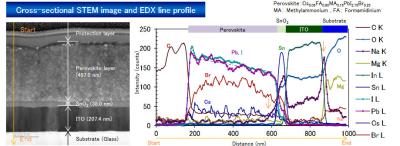Toray Research Centre (TRC) has been developing cutting-edge perovskite solar cells analysis services since 2014. The company can perform a wide range of measurements and tests, on a wide range of perovskite panel types, without atmospheric exposure, at the company’s state-of-the-art facilities.
TRC’s highly skilled technical team recently published five technical white papers, each showcasing perovskite analysis results.
- Evaluation of electrical characteristics and crystalline in perovskite solar cells: TRC evaluated to surface roughness and the distribution of spreading resistance near the surface by SSRM. The result showed that the regions of high spreading resistance on the surface of the PVK layer increase with heat treatment. TRC also performed ACOM-TEM analysis and it revealed a decrease in PVK phase and particle size, and an increase in PhI2 phase with heat treatment.
- Surface analysis of power generation layer for Perovskite Solar Cells: X-ray diffraction (XRD), SEM (Secondary Electron Microscopy), and SSRM (Scanning Spread Resistance Microscopy) can evaluate the crystal structure, the form of the surface, the distribution of element, and spread resistance.
- Evolved gas analysis by TPD-MS and depth profile analysis by SIMS of perovskite solar cells: To improve the heat treatment during the perovskite solar panel production process, it is important to understand the decomposed gases from the material and the composition distribution in the material. In this paper, TRC shows the evaluation results of evolved gases during heating by TPD-MS and the elemental distribution in the depth direction by GCIB-TOF-SIMS and Dynamic-SIMS
- Depth profile analysis to element and organic matter of Perovskite Solar Cell: Cross-sectional TEM, Dynamic-SIMS(D-SIMS) and GCIB-TOF-SIMS can be performed the distribution of element and organic matter with high spatial resolution and high sensitivity under non-exposed atmospheres. These processes are very helpful for the improvement of process, materials and devices of PSC
- Composition and impurity analysis of light absorbers of perovskite-based solar cells: It is important to figure out the concentration of composition and impurity of light absorbers to achieve high efficiency in perovskite-based solar cells. For the analysis of inorganic elements, ICP-AES, ICP-MS and ion chromatography are available.
TRC offers its unique and high-quality analysis services to perovskite solar panel developers and producers - click here to inquire about TRC's services. TRC’s analysis services can assist in finding process flaws, increase device performance and accelerate R&D efforts.
TRC is also working with leading researchers assisting in perovskite material and solar panel research. One such example is a recent paper published in collaboration with Dr. Wakamiya from Kyoto University, titled: “Optimized carrier extraction at interfaces for 23.6% efficient tin-lead perovskite solar cells”. This paper described research conducted by Kyoto University, TRC, RIKEN, and the University of Tsukuba, and was published in the Energy and Environmental Science journal. You can read it from Kyoto University Research Information Repository (KURENAI).
This was a sponsored post by Toray Research Center

